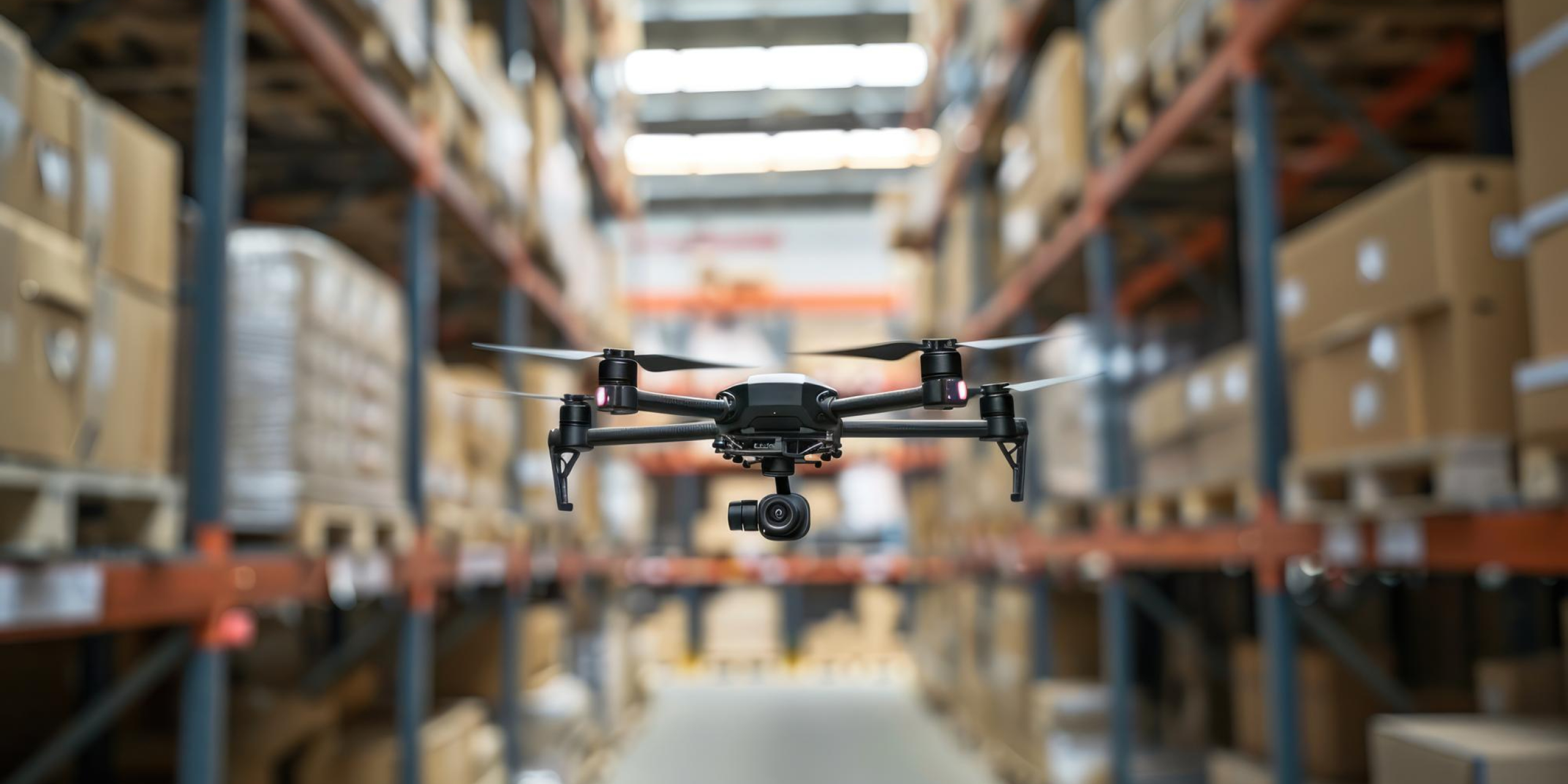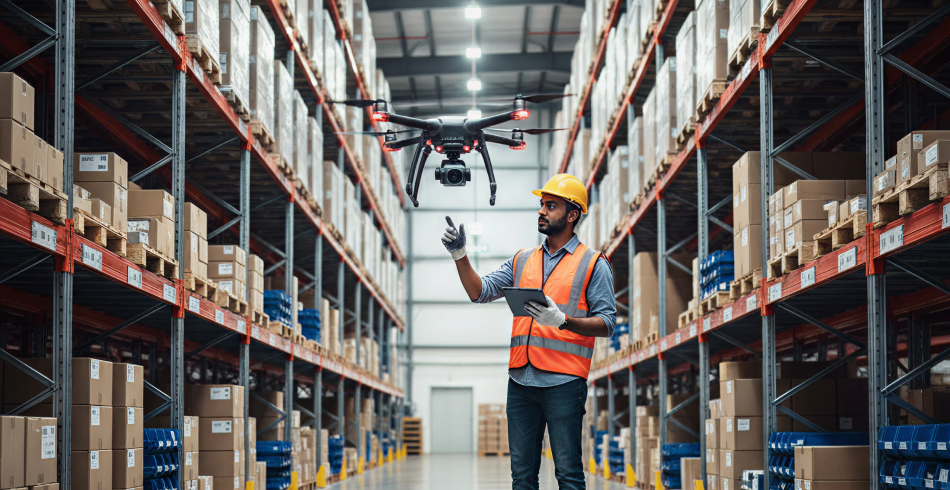Drone Inventory Audits: Cutting Stock-Taking Time from Days to Hours

It’s a sight familiar to anyone who has worked in a warehouse during the festive quarter. Racks stretching sky-high with cartons, forklifts buzzing, workers squinting to count and cross-check barcodes. The clock is ticking, orders are piling up, and somewhere on the mezzanine, a tired associate double-counts the same pallet for the third time.
For decades, this has been the rhythm of stock audits: manual, time-consuming, and prone to error. In the world of logistics, where every minute and every carton matters, it’s an old problem in desperate need of a new solution.
That solution is now taking flight – literally.
The New Eye in the Sky
Drone technology, once seen as futuristic, is quietly becoming a practical tool for inventory management. Equipped with high-resolution cameras and AI-powered scanning, drones can fly through aisles, scan labels on racks stacked 30 feet high, and feed real-time data directly into inventory systems.
What once took a warehouse team three days with ladders, scanners, and endless spreadsheets can now be done in three hours. And accuracy isn’t sacrificed – in fact, it often improves, as drones reduce the risk of human fatigue and oversight.
For businesses heading into the year-end rush, this isn’t just innovation – it’s survival.
The Festive Imperative
In India, the last quarter of the calendar year is a perfect storm in a cup for supply chains. Ganesh Chaturthi flows into Navratri, Diwali into Christmas, Christmas into New Year sales. By October, warehouses are bursting with incoming stock; by November, they’re working around the clock to push it out.
Any delay in inventory audits during this period is costly. A misplaced stock keeping unit (SKU) or an inaccurate stock count can cascade into delayed deliveries, cancelled orders, or lost sales at the very moment when demand is peaking. Drones, by compressing inventory audit cycles from days to hours, free up time, space, and manpower to focus on what matters most: getting festive orders to customers, on time and in full.
Global Signals, Local Momentum
Globally, the logistics majors have already embraced this shift. DHL piloted drones in its European warehouses to cut audit times significantly. [1] Amazon has integrated aerial scanning into its smart fulfilment centres. [2] Even traditional players like Walmart are experimenting with drone-driven inventory to improve real-time visibility. [3]
India is catching up fast, with trials going on and producing encouraging results. As the technology gets cheaper and regulation clearer, adoption is set to accelerate – especially as festive demand makes the business case undeniable.
Inside a Drone Inventory Audit
Picture this: an ecommerce fulfilment center at a Horizon Industrial Park in NCR, prepped for Diwali surge. Instead of halting operations for a manual stock take, a fleet of small drones lifts off at dawn. They glide through aisles with precision, scanning QR codes, cross-referencing ERP data, and flagging anomalies instantly.
The warehouse floor never stops. Forklifts keep moving, staff stay focused on order fulfilment, and managers receive live dashboards showing exactly what’s where. What used to be a logistical bottleneck is now a smooth, almost invisible background process.
The result? Faster audits, fewer errors, safer working conditions (no more ladders and precarious climbs), and better deployment of human resources.

The Business Case
The economics is compelling. A typical manual audit in a large warehouse can consume hundreds of man-hours. Factor in downtime, overtime, and error correction, and the cost balloons further.
Drones, by contrast, reduce the audit window dramatically while enabling continuous operations. Early adopters report high accuracy levels, significant reductions in labour hours, and improved safety records. Over the long term, the savings more than offset the investment, especially for companies handling high volumes of SKUs during festive peaks.
The Human Angle
Technology stories often feel cold until you zoom in on the people they touch and thereby understand the ways it changes real lives. Integration of drones for these audits are a game changer in efficiency. In the past, the audits of inventory supervisors meant 12-hour shifts with the team climbing racks, scanning labels, and manually reconciling counts. Fatigue was inevitable, and mistakes were common.
But now drones can handle the scanning. The team still shall play a critical role – but now focusing on oversight, analytics, and problem-solving instead of sheer grunt work. Jobs are safer, more strategic, and more satisfying. And the company’s customers? They just notice that their festive orders arrive on time.
The Future Takes Flight
As India’s warehouses scale up for a trillion-dollar manufacturing and e-commerce economy, drone audits won’t remain an experiment; they’ll become the norm. Regulators are already easing pathways for commercial drone use, and AI-integrated platforms are making the technology plug-and-play.
For businesses, the choice is simple. Stick with manual audits and risk lagging behind during peak season, or embrace drones and gain the gift of speed, accuracy, and festive readiness.
Because the drones shall be integrated with the warehouse’s WMS, every scan updates the live dashboard. Managers can monitor stock positions, identify discrepancies instantly, and make quick allocation decisions – all without pausing warehouse activity. Forklifts keep moving, staff stay focused on fulfilment, and the audit happens almost invisibly in the background.
The Horizon Perspective
We, at Horizon Industrial Parks, provide intelligent, future-ready designs that make this possible. Our Grade-A warehouses are thoughtfully engineered with wide aisles for the smooth movement of MHE, generous clear heights, and optimised column grids that enhance operational flexibility and visibility. These features don’t just improve circulation within the warehouse; they future-proof it. By enabling seamless integration of emerging technologies such as drone-based inventory management, our infrastructure ensures that occupiers can evolve their operations with minimal disruption and maximum efficiency.
Closing Thought
Drone-enabled inventory audits represent more than just a technological upgrade – they signal a shift in how warehouses think, operate, and optimise. What was once a slow, manual task has become an intelligent, continuous process powered by data, automation, and precision. As drones integrate seamlessly with warehouse management systems, real-time visibility becomes the new standard and operational downtime a thing of the past.
The warehouse of tomorrow isn’t defined by how much it stores, but by how intelligently it moves, measures, and manages – and drones are helping that future take shape today.